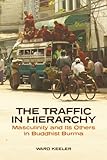The Traffic in Hierarchy : Masculinity and Its Others in Buddhist Burma / Ward Keeler.
Material type: TextPublisher: Honolulu : University of Hawaii Press, [2017]Copyright date: ©2017Description: 1 online resource (352 p.)Content type:
TextPublisher: Honolulu : University of Hawaii Press, [2017]Copyright date: ©2017Description: 1 online resource (352 p.)Content type: - 9780824865948
- 9780824865979
- 950
- online - DeGruyter
- Issued also in print.
| Item type | Current library | Call number | URL | Status | Notes | Barcode | |
|---|---|---|---|---|---|---|---|
 eBook
eBook
|
Biblioteca "Angelicum" Pont. Univ. S.Tommaso d'Aquino Nuvola online | online - DeGruyter (Browse shelf(Opens below)) | Online access | Not for loan (Accesso limitato) | Accesso per gli utenti autorizzati / Access for authorized users | (dgr)9780824865979 |
Browsing Biblioteca "Angelicum" Pont. Univ. S.Tommaso d'Aquino shelves, Shelving location: Nuvola online Close shelf browser (Hides shelf browser)

|

|

|

|

|

|

|
||
| online - DeGruyter The ‘Ukulele : A History / | online - DeGruyter Japanese Cinema in the Digital Age / | online - DeGruyter Ancient Ryukyu : An Archaeological Study of Island Communities / | online - DeGruyter The Traffic in Hierarchy : Masculinity and Its Others in Buddhist Burma / | online - DeGruyter Urban Reinventions : San Francisco's Treasure Island / | online - DeGruyter Monastery, Monument, Museum : Sites and Artifacts of Thai Cultural Memory / | online - DeGruyter Encounters Old and New in World History : Essays Inspired by Jerry H. Bentley / |
Frontmatter -- Contents -- Preface -- Acknowledgments -- Introduction. Hierarchy in Traffic -- Chapter One. Everyday Forms of Hierarchical Observance -- Chapter Two. A Description of the Shweigyin Monastery -- Chapter Three. Discretionary Attachments: Monks and Their Social Relations -- Chapter Four. Taking Dumont to Southeast Asia -- Chapter Five. Hierarchical Habits -- Chapter Six. Gaining Access to Power -- Chapter Seven. Meditation -- Chapter Eight. Masculinity -- Chapter Nine. Masculinity's Others: Women, Nuns, and Trans Women -- Chapter Ten. Taking Autonomy and Attachment Further Afield -- Notes -- References -- Index
restricted access online access with authorization star
http://purl.org/coar/access_right/c_16ec
Until its recent political thaw, Burma was closed to most foreign researchers, and fieldwork-based research was rare. In The Traffic in Hierarchy, one of the few such works to appear in recent years, author Ward Keeler combines close ethnographic attention to life in a Buddhist monastery with a broad analysis of Burman gender ideology. The result is a thought-provoking analysis of Burmese social relations both within and beyond a monastery's walls. Keeler shows that the roles individuals choose in Burman society entail inevitable trade-offs in privileges and prestige. A man who becomes a monk gives up some social opportunities but takes on others and gains great respect. Alternatively, a man can become a head of household. Or he can choose to take on a feminine gender identity-to the derision of many but not necessarily his social exclusion. A woman, by contrast, is expected to concern herself with her relations with family and kin. Any interest she might show in becoming a nun arouses ambivalent reactions: although it fulfills Buddhist teachings, it contravenes assumptions about a woman's proper role. In Burma, hierarchical understandings condition all relationships, but hierarchy implies relations of exchange, not simply inequality, and everyone takes on subordinate roles in their bonds with some, and superordinate ones with others. Knowing where power lies and how to relate to it appropriately is key. It may mean choosing at times to resist power, but more often it involves exercising care as to whom one wishes to subordinate oneself, in what ways, and on what terms.Melding reflections on the work of theorists such as Dumont, Anderson, Warner, and Kapferer with close attention to the details of Burman social interaction, Keeler balances theoretical insights and ethnographic observation to produce a rich and challenging read. The conundrum at the heart of this book-whether to opt for autonomy, the Buddhist seeking of detachment, or for attachment, the desire for close bonds with others-is one that all humans, not just Burmans, must confront, and it is one that admits of no final resolution.
Issued also in print.
Mode of access: Internet via World Wide Web.
In English.
Description based on online resource; title from PDF title page (publisher's Web site, viewed 02. Mrz 2022)


